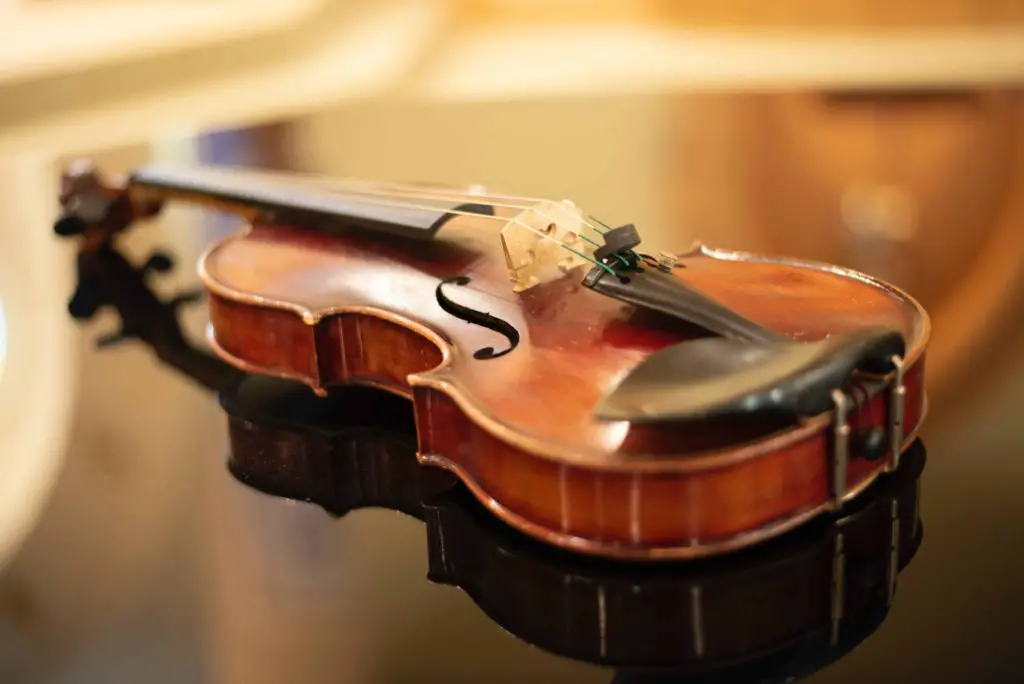The bridge of the violin is responsible for two functions that play a crucial role in producing sound: it helps to transfer the sound from the strings to the sound post and it holds up the strings.
In order to best transfer sound from the strings to the body of a violin, a bridge should be fitted with notches. These notches are cut into a violin’s bridge so that there is one notch for each string on the violin.
The primary reason for cutting notches in the bridge is to set the string heights correctly. Notches on the bridge should be 1/3 to 1/2 the diameter of the strings. The strings shouldn’t be buried into the bridge but they also shouldn’t be just sitting on top of the bridge.

Table of Contents
Why Is The Bridge Of The Violin Important
The strings of the violin are placed across the bridge in such a way that raises them off the fingerboard, causing the vibrations of the strings to be transferred to the body of the violin. The bridge makes it possible for the sound of the violin to be amplified. The bridge is also necessary for the violinists to bow each individual string.
What Makes A Good Violin Bridge
Some of the characteristics of violin bridges can make a difference in your violin’s sound quality. A few of those characteristics include the shape of the bridge, the quality of the wood used to make the bridge, and the thickness of the bridge.
The shape of the violin bridge is one factor that makes a difference in your violin’s sound quality. The top of the bridge is shaped in an arch so that each string of the violin sits at the right height. The proper bridge shape makes it easier for violinists to finger the notes on the strings.
Also, the type of wood that is used matters. In general, seasoned maple wood is the best type of wood used to create a violin bridge. The piece of wood used as a blank bridge has a big influence on the overall tone of the instrument. To achieve the best results, the luthier will select a strong, light piece of maple wood to shape the bridge from.
Finally, the thickness of wood is important. Having a bridge that is too thick will lower the frequency of the bridge, dampening the vibration of your violin’s strings. This dampening will cause your violin to sound muted.
Conversely, if the bridge’s wood is too thin, the sound will come out as very bright and too high-pitched.
How Is A Violin Bridge Attached
The violin bridge, like other parts of the violin, is designed to be easily adjusted or replaced without having to replace your entire violin. Thus, a violin bridge is held into place by the tension of the strings and is never glued to the body of the violin.
5 Reasons Your Violin Bridge Keeps Falling
There are several reasons that your violin bridge may be falling. Here are the 5 most common reasons:
First, the bridge may be warped. Violin bridges tilt during regular tuning. If these bridges are not straightened after they are tilted, over time they will warp. A warped bridge will need to be replaced.
Second, the bridge was never properly fitted for your violin when it was made. Poorly fitted feet can cause there to be insufficient wood-to-wood contact between the bridge and the violin.
The third reason your violin may keep falling is due to ordinary wear. You tune your violin each time you play. Over time, the bridge may start to lean and eventually fall.
The fourth possible reason the violin bridge may be falling is that the bridge is not straight while you’re tuning your instrument. Be sure the bridge is straight whenever you tune your violin.
Fifth, the violin is cheap and the bridge was not cut correctly. Inexpensive violins rarely have a bridge that is cut and placed correctly.
What To Do If The Violin Bridge Falls
When your bridge falls, you will either need to take your violin to a luthier for repair or fix it yourself. To repair the fallen bridge, loosen the strings slightly. Use both hands to place the bridge into place, aligning the feet with the f-hole notches. As you bring the strings back into tune, watch the bridge and straighten it if it tilts too far forward.
The video below demonstrates the process you should use to fix a fallen bridge. Some key tips from the video include:
- Be sure you have the bridge turned in the right direction. The back side of the bridge is often stamped with the brand name. The front of the bridge faces the fingerboard. The back of the bridge goes towards the tailpiece.
- You can determine the bridge’s sides by using the curve. The shorter side is the treble side where the e-string sits.
- When repairing the bridge, place the violin on a towel or blanket to cushion it.
- Place a soft towel between the tailpiece and the top of the instrument to protect the violin’s wood surface.
- The feet of the bridge should line up with the inner notches of the f-holes.
- The bridge should always remain in full contact with the top of your violin. There should be no gapping at the feet and no titling towards the fingerboard or the tailpiece.
- A titled or warped bridge can cause the strings to buzz on the fingerboard; so, it’s important to check the position of the bridge every time you tune your violin.
Can You Fix The Bridge On A Violin
You can certainly replace a bridge when it has fallen; but, can you fix the bridge itself when it is warped or broken? The short answer is no.
The bridge is crucial for the violin’s sound and should not be repaired if warped or broken. Violin bridges (check the prices on Amazon) are not very expensive and are well worth the cost of replacement.
Related Questions
What is a self-adjusting violin bridge?
A self-adjusting violin bridge is a bridge that has feet that swivel to match the curves and contours of the top of the violin.
Since the fit of the feet of the bridge is essential for achieving a good sound from your violin, it would seem that the self-adjusting bridge is a good idea. However, many violin players complain that these bridges don’t fit as well as they need to and usually need to be trimmed.
Are violin bridges glued?
Violin bridges are not glued onto violins.
Can you glue a broken violin bridge?
A broken bridge can have a negative impact on the violin’s sound. Therefore, it is not advisable to glue a broken violin bridge for use on your violin.
What are violin bridges made of?
Violin bridges are made of maple wood.

